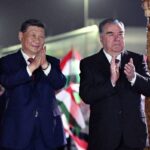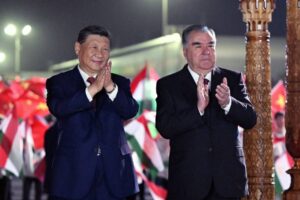Relief group funded by US Christian donors provides assistance and hope to displaced populations in Myanmar’s war-torn Kayah state
Thoo Rey’s body lies under a foil blanket in a field hospital. The 24-year-old Karenni man’s open eyes and mouth reflect the stupefaction that only a brutal and unexpected death can bring.
His killing was precisely that. Two hours before, he was walking in his abandoned village in Kayah state’s Demoso district to fetch personal belongings when shrapnel from a mortar launched a few kilometers away by the Myanmar Army hit him fatally in the neck.
His name is now among the estimated 3,000 civilians killed by Myanmar security forces since the February 1, 2021, democracy-suspending coup. Before his death, Thoo Rey was among the countless internally displaced people (IDPs) who have fled their villages and moved to more secure ground mostly in forest and hill areas across civil war-wracked Kayah state.

Free Burma Rangers, the only foreign relief group to work with IDP communities from inside Kayah, estimates the state’s number of IDPs at 300,000. In the two years since the coup, hundreds of villages and hamlets have been deserted by their inhabitants, FBR says.
The IDPs have fled mortars and airstrikes, the proximity of fighting and the sinister threat of the Myanmar army’s imminent arrival in their villages. The army has destroyed and burnt down more than 1,100 houses since the coup, according to the Karenni Human Rights Group (KHRG), an independent rights monitoring group.
Soon after this correspondent’s trip, the Myanmar military launched a new offensive in a visited area in which 22 villagers, including three Buddhist monks, were massacred in southern Shan state near Kayah state’s border.
Wandering through these ghost villages, it is clear that people had only enough time to lock their doors and close their front gardens with bamboo barriers before fleeing. Forgotten drying cloths hang covered in dust while bananas are left to rot on thirsty trees. All around, unattended rice fields are overrun by wild cacti and other invasive vegetation.
Traces of Myanmar military mortars and airstrikes testify to the junta’s civilian-targeting violence. At an intersection on a road close to Demoso, a woman shows a crater left the previous night by a mortar that landed on a volleyball court just a dozen meters from an IDP makeshift market.
“They launched five bombs, including one from a drone. Two people were injured, one badly, who was transported to Luke Hospital (a field facility run by the resistance in the jungle). Nowhere is safe for us,” she laments.
The Myanmar military, or Tatmadaw, has put a particular target on Christian minority places of worship. In Daw Ngay Khu, a village in Hpruso township, stands the bombed and burnt-out remains of a church named St Matthew’s.
A jumble of twisted corrugated plates and steel beams litter a floor surrounded by naked walls on the brink of collapse. Somehow, the bell tower and its cross remain intact. In another region further south, bombs and gunfire from a Myanmar military airplane have reduced a Catholic chapel to rubble.
IDPs are omnipresent across Kayah state. In nearly every valley, along every road and in every forest on the side of every hill visited by this correspondent, green tarpaulins labeled “Made in Korea” serve as roofs for makeshift bamboo houses and huts.
One of these IDP communities has settled along the Pawn River, in the state’s center. Here, around 900 civilians, mostly farmers from Loikaw, Kayah state’s capital district, are split into four “sub-camps.”
“We have made the long way in vehicles, ours or rented, a year ago,” explains Byar Reh, a 63-year-old man who is chief of Camp 4. “Before the coup, we had a lot of freedom, we were happy.”
Apart from the precious water from the river, this area, a dramatically dry plateau, lacks the resources for basic survival. “Here the soil is very poor, the only crop that grows is sesame. We have to pay a rent to the land’s owner, we send the production to Loikaw,” he adds.
“Life is very difficult,” confirms Boe Mya, a 35-year-old widow with six children. “In my village, I grew rice and raised cattle. Here for the food we have to rely on other people.”
In other communities, IDPs have managed to organize a basic economy. “People grow vegetables, raise pigs and chicken, fetch woodfire that they sell to each other but it’s still very limited”, comments a community leader.
Schools, clinics and other services such as water supply are provided by local opposition groups, mainly the Karenni National Progressive Party (KNPP) and Karenni Nationalities Defense Force (KNDF). Sometimes, when the security situation allows, families return to their abandoned homes to tend a field or care for their cattle.
“It can be very risky, Burmese [Myanmar] soldiers plant landmines in the villages and if they see you, they will capture and kill you,” says camp leader Byar Reh. “I know a family of five who had returned to their home, they were spotted and caught. The father and son-in-law were killed; the mother, daughter and grandchild were released later.”

Tensions can also rise between IDPs and neighboring villagers. Although there is a strong tradition of mutual assistance in these ethnic territories, sometimes competition for resources – water, food, wood – erupts into conflict. “There are cases where villages have asked IDPs to move to other locations,” acknowledges a Karenni leader.
It does not help that IDPs get very little aid from outside. United Nations agencies and big international nongovernmental organizations (INGOs) are conspicuous by their absence. (Sporadic aid in 2022 from Save The Children and World Vision were mentioned by some IDPs).
Material assistance is essentially provided by a handful of local NGOs and the FBR, a Christian-led multi-ethnic humanitarian service movement founded in 1997 and financed mostly by Christian private donors from the US.
FBR provides education for administering basic medical assistance, media reporting and other humanitarian functions and is staffed mostly by young volunteers. They come mostly from ethnic minority armed groups, but since the coup, the FBR has taken in Bamar (Myanmar’s ethnic majority) members from the Civil Disobedience Movement (CDM) and other opposition groups.
“Amongst the 250 graduates in 2022, there were almost 40 Bamar ethnics. This is the very first time, it’s encouraging”, says David Eubank, a 62-year-old former US Army Special Forces soldier who serves as FBR’s founder and director.
After a two-month training in a camp near the Thai border, teams of “Rangers” – as they call themselves – are sent all over the country to assist displaced and oppressed populations.
In Kayah state, FBR teams move from camp to camp to offer material and moral help to IDPs, including medical consultations where medics examine patients and deliver basic treatment and medicine, distribute food, blankets and other emergency equipment.
and perform the Good Life Club (GLC), three-hour entertainment shows aimed at children involving theater plays, games, songs and raising health awareness skits that end with the distribution of cloths and candies.
“In two years, only in Kayah state, we have provided at least 12,000 tarpaulins, food and other material assistance to IDPs and helped to evacuate 100,000 of them with our own vehicles or by providing gas,” adds Eubank.
As for GLC programs, “they bring hope and love, tools for an abundant life, body and soul, we want to give the kids some tools, spiritually to have courage and hope, physically to understand sickness and health and be strong bodies”, says 54-year-old Karen Eubank, David’s wife and GLC’s creator.
At the same time, FBR members often face extreme danger on the frontline. FBR medics provide first aid to casualties – they have saved lives by amputating injured soldiers and civilians in the field – while media-trained staff document ongoing situations and send reports to the outside world. Since the coup, 18 Rangers have lost their lives due to Myanmar military fire.
Aung Zay Ya is one of the leading GLC hosts, a “career change” he says he would have never imagined. Before the coup, the 26-year-old Burmese citizen of Chinese origin was making a comfortable living as a mechanical engineer in a Yangon company equipping Ferrari and Lamborghini for wealthy Burmese.
“Two weeks before the coup, I had signed a seven-year contract with my boss that was going to send me to Singapore to complete my degree and then come back to Myanmar to work. Then the coup came. I was not really interested in politics, but the killing of young protestors in Yangon pushed me to join the underground movement,” he says.
After months of wandering from place to place, he landed in a FBR training camp where his talent was spotted and nurtured. “This is my revolution,” he adds. “At the beginning, I only wanted to win, but now I don’t care about winning or losing, I only want to help the people.”
Other young revolutionaries tell similar tales. Doris, a 25-year-old female Karenni, had an international sporting career before joining the youth revolution. In 2013, at the age of 16, she won a bronze medal in the 800-meter competition at the Southeast Asia Games.
“Before the coup,” she smiles, “I was a professional athlete within a military federation. After, I joined the KNDF and then a FBR training. As a FBR Ranger, I can serve everything, evacuate the injured and help the medics on the frontline, participate in GLC programs.”
FBR also provides financial assistance to individual projects such as the Nway Oo Guru Lay Myar social welfare group founded by Khin Sandar Nyunt, a 35-year-old Bamar anthropologist from Yangon. The group’s flagship project is an alternative education center built on a Pawn River bank.
“I want a revolution not only on the battlefield but also in education,” she says. “Here, in one year, our 18 teachers – full and part-time – have already given an alternative curriculum in Karenni and English languages to more than 165 young students. We teach them organic farming, music, arts and crafts. At the beginning, I was upset but now I have hope, I believe that it will take two or three more years for the revolution to succeed.”
Within IDP communities, the Myanmar junta’s official justification for their brutal campaign against civilians – fighting “terrorist groups” threatening the country’s unity – is a tired refrain that lacks credibility.
Wisaysha, a 43-year-old Karenni woman, found shelter in an IDP camp last year after her husband and two other men were stabbed to death by Myanmar soldiers and thrown into a latrine while returning to their village to retrieve belongings. “I don’t know why they do that,” she cries. “They are hungry with power, they just want to oppress the people.”
Indeed, the future is still bleak for Kayah state’s IDPs. As long as the Myanmar military stays on the offensive and maintains its threats against civilians, there is little chance they will return to their villages any time soon.
Boe Mya, the widow from the Pawn River IDP settlement is under no illusions: “We hope to return, but the Burmese [military] have the power and we disagree with them, so…”
















